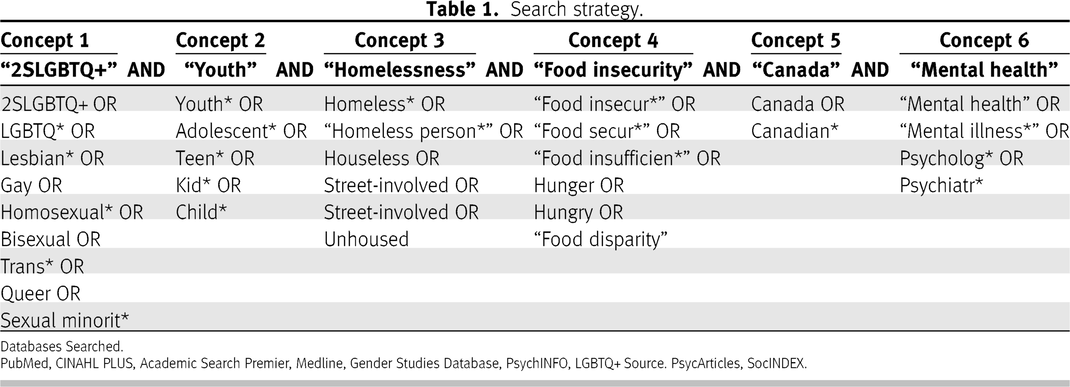Our search strategy identified 1770 papers, of which 28 were related to our research question and evaluated by our team. None of the papers examined food insecurity in connection with mental health among street-involved 2S/LGBTQI+ youth in Canada.
However, a single report touched briefly upon each dimension of the research question but did not formally examine connections between mental health and food insecurity. The report was an evaluation of the 2015–2017 RainCity LGBTQ2S Housing First Project [
38] which assisted 2S/LGBTQI+ youth in Vancouver with housing. The mixed-method evaluation consisted of 2 surveys (13 participants completed the intake and 15 the follow-up) and 7 focus groups. All participants had experienced housing precarity and mental health concerns at the time of their admittance to the program. At the conclusion of the program, participants reported improvements in their housing stability, substance use behaviours, skills, knowledge of supports, and how to access them. Program staff reported that they were unable to meet participants’ food needs, but nevertheless saw a reduction in reports of “going to bed hungry” [
38(p.
31)] and 60% of participants reported an improvement in access to healthy food items which they credited to their participation in the program.
Secondary results
While there is a paucity of research directly addressing the research question at hand, 24 studies addressing adjacent and contributing factors were identified (Supplemental File 2). As the issues of food insecurity and mental health among street-involved Canadian 2S/LGBTQI+ youth are deeply intertwined with factors such as poverty, resource access, and home environments, it is important to highlight contextual information identified in the literature.
For present purposes, the secondary results presented below are sources which included discussion of 2S/LGBTQI+ population(s), street-involvement and/or housing precarity including a Canadian context, and at least one of the other dimensions of the research question.
2S/LGBTQI+ Youth and Housing Precarity: Conflict in the family home is a major contributing factor to youth becoming street-involved [
39,
40]. Many street-involved 2S/LGBTQI+ youth report having left their family houses as a result of physical or sexual abuse, homophobia, and transphobia in the home [
36,
39,
41].
Moreover, many street-involved 2S/LGBTQI+ youth, a highly mobile group [
41], feel safer on the streets than in shelters due to the homophobic and transphobic violence that continues to exist in shelter systems [
33]. There is also evidence suggesting that homophobic and transphobic discrimination and harassment occurring in Canadian shelters is significantly underreported [
33]. Discrimination against transgender youth in these settings is particularly concerning [
42] and may be in part due to many shelters’ policies regarding gender separation in sleeping spaces, bathrooms, and locker rooms [
36,
38]. Some Canadian shelters have trialed designating specific beds for transgender youth; however, if bed placement is dependent upon shelter staffs’ perception rather than how users self-identify, this may draw additional attention to transgender shelter guests, further contributing to discrimination [
42].
Discrimination in shelter systems not only reinforces street-involvement but also affects 2S/LGBTQI+ youth’s mental health. Although street-involvement and/or housing precarity places all youth at risk for worse mental health outcomes, 2S/LGBTQI+ youth are at higher risk due to stigma and discrimination and experience “alarmingly high” rates of suicidality and depression [
41(p.
37)].
Food resource use: 2S/LGBTQI+ adults are significantly more likely to experience food insecurity compared to their heterosexual and cisgender peers [
36]. Additionally, once street-involved and cut off from familial financial support, 2S/LGBTQ+ youth report obtaining money for food as salient among their concerns [
43].
Despite evidence that food charities are ineffective in mitigating food insecurity [
6,
44–
46] and that the number of food insecure Canadians exceeds the number using food banks [
46], food banks are often the first response to food insecurity in high-income countries such as Canada [
6]. Furthermore, Canadian qualitative research suggests that shelters frequently fail to meet users’ dietary restrictions, intolerances, or allergies [
39]. Although such support services have been noted as crucial for 2S/LGBTQI+ youth [
47], Hackett et al. [
48] found that often 2S/LGBTQI+ youth relied on informal friendship networks to meet their basic subsistence needs. Ultimately, food charities are not a viable long-term solution and serve to undermine government’s responsibility to protect the right to food [
49].
2S/LGBTQI+ youth and mental health: Homeless and street-involved 2S/LGBTQI+ youth experience elevated risks for a wide variety of mental health concerns, suicide contemplation, substance use disorders, and engaging in risky sexual behaviour [
50–
53], and it is likely that these risks are exacerbated by lack of access to safe, structurally competent resources whose policies recognize that larger institutional forces shape their interactions with services such as housing and food supports [
33]. Street-involved Canadian youth have reported they worry that accessing available mental health supports would lead to further stigma [
39]. Additionally, gender diverse Canadians are five times more likely to have mental health concerns, five times more likely to attempt suicide, and twice as likely to experience homelessness and severe poverty [
34]. What is more, 2S/LGBTQI+ youth ‘couch surfing’ or sleeping outdoors report even higher rates of concern regarding their mental health than those sleeping in the shelter system [
41]. Substance use is also reported to occur at higher rates for street-involved youth, and for 2S/LGBTQI+ street-involved youth is reported to be yet higher [
51]. It is imperative to note that these poorer outcomes are not related to being a member of the 2S/LGBTQI+ communities in and of itself but rather are due to the experience of stigma-related discrimination and trauma rooted in cis-heterosexist societal norms, biases, and systems [
54].




